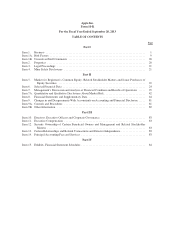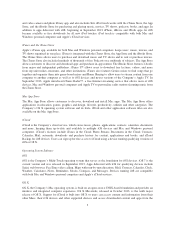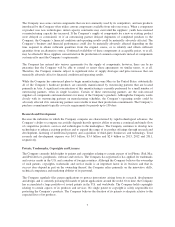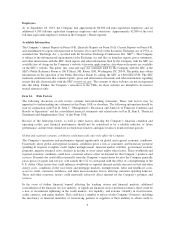Apple 2013 Annual Report Download - page 10
Download and view the complete annual report
Please find page 10 of the 2013 Apple annual report below. You can navigate through the pages in the report by either clicking on the pages listed below, or by using the keyword search tool below to find specific information within the annual report.Many of the Company’s products are designed to include intellectual property obtained from third parties. It may
be necessary in the future to seek or renew licenses relating to various aspects of its products, processes and
services. While the Company has generally been able to obtain such licenses on commercially reasonable terms
in the past, there is no guarantee that such licenses could be obtained in the future on reasonable terms or at all.
Because of technological changes in the industries in which the Company competes, current extensive patent
coverage, and the rapid rate of issuance of new patents, it is possible that certain components of the Company’s
products, processes and services may unknowingly infringe existing patents or intellectual property rights of
others. From time to time, the Company has been notified that it may be infringing certain patents or other
intellectual property rights of third parties.
Foreign and Domestic Operations and Geographic Data
During 2013, the Company’s domestic and international net sales accounted for 39% and 61%, respectively, of
total net sales. Information regarding financial data by geographic segment is set forth in Part II, Item 7 of this
Form 10-K under the subheading “Segment Operating Performance,” and in Part II, Item 8 of this Form 10-K in
the Notes to Consolidated Financial Statements in Note 11, “Segment Information and Geographic Data.”
While substantially all of the Company’s hardware products are currently manufactured by outsourcing partners
that are located primarily in Asia, the Company also performs final assembly of certain products at its
manufacturing facility in Ireland. The supply and manufacture of a number of components is performed by sole-
sourced outsourcing partners in the U.S., Asia and Europe. Margins on sales of the Company’s products in
foreign countries, and on sales of products that include components obtained from foreign suppliers, can be
adversely affected by foreign currency exchange rate fluctuations and by international trade regulations,
including tariffs and antidumping penalties. Information regarding concentration in the available sources of
supply of materials and products is set forth in Part II, Item 8 of this Form 10-K in the Notes to Consolidated
Financial Statements in Note 10, “Commitments and Contingencies.”
Business Seasonality and Product Introductions
The Company has historically experienced higher net sales in its first quarter compared to other quarters in its
fiscal year due in part to seasonal holiday demand. Additionally, new product introductions can significantly
impact net sales, product costs and operating expenses. Product introductions can also impact the Company’s net
sales to its indirect distribution channels as these channels are filled with new product inventory following a
product introduction, and often, channel inventory of a particular product declines as the next related major
product launch approaches. Net sales can also be affected when consumers and distributors anticipate a product
introduction. However, neither historical seasonal patterns nor historical patterns of product introductions should
be considered reliable indicators of the Company’s future pattern of product introductions, future net sales or
financial performance.
Warranty
The Company offers a limited parts and labor warranty on most of its hardware products. The basic warranty
period is typically one year from the date of purchase by the original end-user. The Company also offers a 90-day
basic warranty for its service parts used to repair the Company’s hardware products. In addition, where available,
consumers may purchase APP or AC+, which extends service coverage on many of the Company’s hardware
products.
Backlog
In the Company’s experience, the actual amount of product backlog at any particular time is not a meaningful
indication of its future business prospects. In particular, backlog often increases in anticipation of or immediately
following new product introductions as customers anticipate shortages. Backlog is often reduced once customers
believe they can obtain sufficient supply. Because of the foregoing, backlog should not be considered a reliable
indicator of the Company’s ability to achieve any particular level of revenue or financial performance.
8























